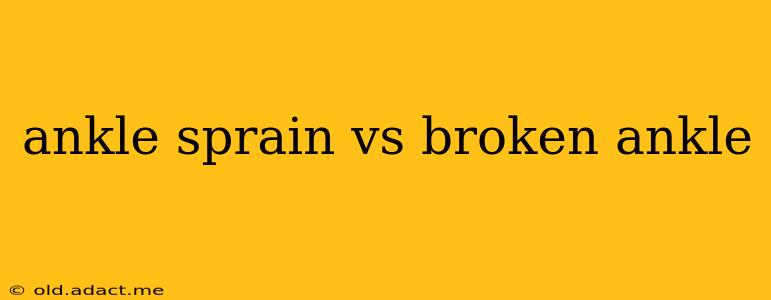Ankle injuries are common, ranging from minor sprains to serious fractures. Knowing the difference between an ankle sprain and a broken ankle is crucial for proper treatment and recovery. This article will delve into the key distinctions, helping you understand the symptoms, diagnosis, and treatment options for each.
What is an Ankle Sprain?
An ankle sprain occurs when the ligaments supporting your ankle joint are stretched or torn. Ligaments are tough bands of tissue that connect bones. These injuries typically happen during sudden twisting or rolling of the ankle, often during sports or activities involving uneven terrain. The severity of a sprain is graded from mild (Grade 1) to severe (Grade 3), depending on the extent of ligament damage.
Symptoms of an Ankle Sprain:
- Pain: Pain is the most common symptom, varying in intensity depending on the severity of the sprain.
- Swelling: Significant swelling usually develops quickly.
- Bruising: Bruising (ecchymosis) around the ankle is common.
- Limited range of motion: Difficulty moving or bearing weight on the affected ankle.
- Instability: A feeling of instability or "giving way" in the ankle.
What is a Broken Ankle (Ankle Fracture)?
A broken ankle, or ankle fracture, involves a break in one or more of the bones that make up the ankle joint: the tibia (shinbone), fibula (smaller bone in the lower leg), or talus (bone in the foot). These fractures can range from hairline cracks to severe, displaced breaks. High-impact trauma, such as falls or car accidents, is often the cause.
Symptoms of a Broken Ankle:
- Severe pain: Intense pain, often immediate and debilitating.
- Deformity: Visible deformity or misshapen ankle.
- Swelling: Significant swelling and bruising.
- Inability to bear weight: Unable to put any weight on the affected ankle.
- Numbness or tingling: Numbness or tingling in the foot or toes.
- Crepitus: A crackling or grating sensation when the ankle is moved.
How to Tell the Difference: Ankle Sprain vs. Broken Ankle
Distinguishing between an ankle sprain and a broken ankle can be challenging, even for medical professionals. While some symptoms overlap, there are key differences:
- Severity of pain: A broken ankle usually causes significantly more intense and immediate pain than a sprain.
- Ability to bear weight: Individuals with broken ankles typically cannot bear any weight on the affected ankle, whereas those with sprains may be able to, albeit with discomfort.
- Deformity: Visible deformity of the ankle is a strong indicator of a fracture.
- Crepitus: The sound or feeling of bone fragments rubbing together is a classic sign of a fracture.
H2: What are the typical treatments for an ankle sprain?
Treatment for ankle sprains typically focuses on the RICE method: Rest, Ice, Compression, and Elevation. Over-the-counter pain relievers like ibuprofen can help manage pain and inflammation. Physical therapy may be recommended to restore strength and range of motion. In severe cases, surgery may be necessary to repair severely damaged ligaments.
H2: What are the typical treatments for a broken ankle?
Treatment for broken ankles depends on the severity of the fracture. Many fractures can be treated non-surgically with immobilization using a cast or splint. However, severe fractures requiring realignment or fixation with plates, screws, or pins may necessitate surgery. Post-surgical rehabilitation is crucial for regaining ankle function.
H2: How long does it take to recover from an ankle sprain?
Recovery time for ankle sprains varies depending on the severity. Mild sprains may heal within a few weeks, while more severe sprains can take several months.
H2: How long does it take to recover from a broken ankle?
Recovery from a broken ankle is typically longer than a sprain and can take several months, or even longer in severe cases. The healing process involves immobilization, followed by physical therapy to restore full range of motion and strength.
H2: When should I see a doctor for an ankle injury?
You should seek medical attention if you experience:
- Severe pain
- Inability to bear weight
- Visible deformity
- Numbness or tingling
- Persistent swelling or bruising
Disclaimer: This information is intended for educational purposes only and does not constitute medical advice. Always consult with a qualified healthcare professional for diagnosis and treatment of any medical condition.
